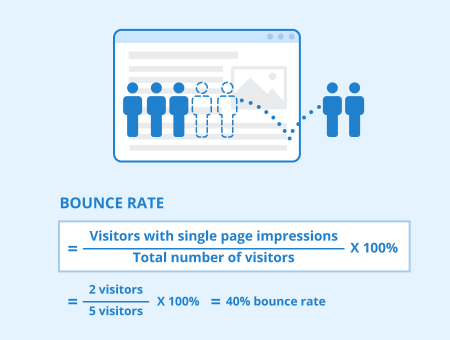Definition
Bounce rate describes the percentage of a website’s visitors leaving the site without moving on to other sub-pages or performing other actions. Actions are defined as, for example, clicking on internal links, downloading files, or staying on the website for a predefined period of time. In contrast to the exit rate, the bounce rate is always based on a single pageview. The exit rate, on the other hand, indicates which sub-pages are visited most frequently before the domain is left.
Calculating the bounce rate

In order to calculate the bounce rate, the total number of visitors with a single page impression is divided by all visitors to the website, which is the simplest form of the bounce rate. Other factors can be included in the calculation to make it more meaningful.
To determine bounce rates, you can use analysis tools such as Google Analytics, which indicate the respective rates of all sub-pages as well as an average value across all pages.
Significance of bounce rates
The bounce rate is a key figure for evaluating the relevance and any necessary adjustments to website content. If the value is low, the content is assumed to be interesting or relevant for users.
Example: If a website’s bounce rate is 17%, the first assumption is that its structure and content are good. The website does not necessarily have to be further optimized. This would be different if, for example, the bounce rate was 71%. In this case, you should find out why the bounce rate is so high.
Reasons for high bounce rates
Besides a poor realization of your website, there are numerous potential reasons that can explain a high bounce rate. For example, users might leave your site due to technical problems on their devices or other distractions. Another potential reason could be that they immediately find the desired information and leave the website without further action. Still, it is possible that the error lies in the website itself or that the user is not satisfied with it for some reason. Possible problems could be:
- bad layout or unappealing design
- bad or unclear structure of the website
- incorrect or faulty content
- poorly phrased content, language problems
- misleading terms
- optimization of the website targeting the wrong keywords
- loading times that are too long
- too much and/or disruptive advertising
- etc.
Ways to reduce your bounce rate
Once you have identified the problem, the following exemplary actions can help to reduce your bounce rate:
- improving design quality or layout
- clearer website design
- adjusting the content to the chosen topic and target group
- linguistic revision of the content
- optimization for more relevant keywords
- reducing loading times
- decreasing the amount of advertising
- etc.
A high bounce rate does not always have to be negative
If your bounce rates are high, this does not necessarily mean there is something wrong with your website. You should not evaluate this value in isolation. Instead, keep an eye not only on your bounce rate but also on goal, purpose, and type of your website and put these factors in relation. For example, it is possible that visitors are not interested in your other sub-pages because, due to the clarity of the first page, they have already found the information they were looking for.
Importance for search engine optimization (SEO)
Google considers bounce rates to evaluate websites as well. However, it’s controversially discussed whether this is a direct ranking factor. Google and other search engines have already recognized that users spend more time on a web page if they like the content or find it useful. But as described above, short dwell times are not necessarily due to users’ dissatisfaction.
To uncover users’ motives, you can also look at your return-to-SERP rate: If visitors leave a page after a short time and return to Google’s search result pages (SERPs), it is obvious that they were not satisfied with the previously visited page. The return-to-SERP rate is thus more reliable than bounce rate alone to measure user behavior and evaluate the quality of a website.
In conclusion, bounce rate can be an important indicator for a website’s performance as it can indicate if you should make adjustments to your website. However, when you are looking for reasons for a high bounce rate, you should thoroughly analyze whether it is due to content, layout, technology, or search engine optimization.
Related links
Similar articles
